 W
WXIII (Thirteen) is a Belgian graphic novel series about an amnesiac who seeks to discover his past. It was created by writer Jean Van Hamme and artist William Vance. It is currently being written by Yves Sente and Youri Jigounov. The storyline of the first five volumes was adapted into a video game in 2003, also titled XIII, which was released on several platforms. A Canadian television film based on the series, XIII: The Conspiracy, was released in 2008. It was followed in 2011 by two seasons of a TV series, each 13 episodes, called XIII: The Series.
 W
WAlix, or The Adventures of Alix, is a Franco-Belgian comics series drawn in the ligne claire style by Jacques Martin. The stories revolve around a young Gallo-Roman man named Alix in the late Roman Republic. Although the series is renowned for its historical accuracy and stunning set detail, the hero has been known to wander into anachronistic situations up to two centuries out of his era. The stories unfold throughout the reaches of the Roman world, including the city of Rome, Gaul, the German frontier, Mesopotamia, Africa and Asia Minor. One voyage goes as far as China.
 W
WThe Worlds of Aldebaran is a French science-fiction comic series written and illustrated by Léo and published by Dargaud in French and Cinebook in English. The Aldebaran saga is divided into 4 cycles: Aldebaran and its sequels Betelgeuse, Antares and Return to Aldebaran. Each cycle is composed of some five albums, and each corresponds to a different planet. Although it is possible to read the cycles separately, they are chronological to form a coherent whole. Each cycle introduces new secondary characters, although the central heroes of the story remain constant.
 W
WAlpha is a Franco-Belgian comics series written by Pascal Renard, illustrated by Youri Jigounov and published by Le Lombard in French and Cinebook in English.
 W
WThe Worlds of Aldebaran is a French science-fiction comic series written and illustrated by Léo and published by Dargaud in French and Cinebook in English. The Aldebaran saga is divided into 4 cycles: Aldebaran and its sequels Betelgeuse, Antares and Return to Aldebaran. Each cycle is composed of some five albums, and each corresponds to a different planet. Although it is possible to read the cycles separately, they are chronological to form a coherent whole. Each cycle introduces new secondary characters, although the central heroes of the story remain constant.
 W
WThe Worlds of Aldebaran is a French science-fiction comic series written and illustrated by Léo and published by Dargaud in French and Cinebook in English. The Aldebaran saga is divided into 4 cycles: Aldebaran and its sequels Betelgeuse, Antares and Return to Aldebaran. Each cycle is composed of some five albums, and each corresponds to a different planet. Although it is possible to read the cycles separately, they are chronological to form a coherent whole. Each cycle introduces new secondary characters, although the central heroes of the story remain constant.
 W
WBlake and Mortimer is a Belgian comics series created by the Belgian writer and comics artist Edgar P. Jacobs. It was one of the first series to appear in the Franco-Belgian comics magazine Tintin in 1946, and was subsequently published in book form by Les Editions du Lombard.
 W
WLes Blondes is a humorous cartoon strip, encapsulating many blonde stereotypes, often those relating to blondes' supposed stupidity.
 W
WBoule et Bill is a popular comic, created in 1959 by Belgian writer-artist Jean Roba in collaboration with Maurice Rosy. In 2003, the artistic responsibility of the series was passed on to Roba's former assistant Laurent Verron. The stories center on a typical family: a man and his wife, their young son Boule and Bill the cocker spaniel.
 W
WCedric is a Franco-Belgian comics series written by Raoul Cauvin, illustrated by Laudec and published by Dupuis in French and Cinebook in English.
 W
WLe Chat was a Belgian daily comic strip, created by Philippe Geluck and published in the newspaper Le Soir from March 22, 1983 until March 23, 2013.
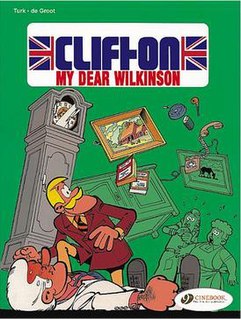 W
WClifton is a Franco-Belgian comics series in the humorous spy-genre, featuring the exploits of Colonel Sir Harold Wilberforce Clifton. It was created by Raymond Macherot in 1959, and has since passed on to other artists and writers. Over the fifty years of publication of the Clifton series, approximately twenty albums and twenty smaller stories have been published, totalling about 800 pages.
 W
WCœurs Vaillants, known later as J2 Jeunes and Formule 1, was a Catholic French language weekly newspaper for French children. Founded in 1929 by l'Union des œuvres catholiques de France, the weekly newspaper targeted readers aged 11 to 14 to become part of l'Action catholique des enfants. The newspaper is notable for introducing The Adventures of Tintin to France, as well as Sylvain et Sylvette, the comics of Marijac, and of Cabu.
 W
WCrusade is a Franco-Belgian comics series written by Jean Dufaux, illustrated by Philippe Xavier and published by Le Lombard in French and Cinebook in English.
 W
WCubitus is a Franco-Belgian comics series, and the basis for the Wowser cartoon series appearing in the United States. Cubitus was created by the Belgian cartoonist Dupa, and features Cubitus, a large anthropomorphic dog, who lives with his owner Semaphore. Cubitus is known as Dommel in Flanders and the Netherlands, Muppelo or Pom Pom in Finland, Teodoro in Italy and Доммель in Russia. His name derives from the old anatomical name of the ulna bone, supposedly derived from the Greek kybiton (elbow).
 W
WLes Femmes en blanc is a Belgian comics humor series of 39 volumes, for which the script was created by Raoul Cauvin and whose design was directed by Philippe Bercovici. Colours were done by Leonardo. The series debuted in 1981 in the Belgian comic book magazine Spirou and the first volume was released in 1986.
 W
WGil Jourdan is a Belgian detective comic strip created by Maurice Tillieux. It is a combination of mystery, adventure and humour.
 W
WGreen Manor is a Franco-Belgian comics series written by Fabien Vehlmann, illustrated by Denis Bodart and published by Dupuis in French and Cinebook in English. I's a humoristic detective series set in the United Kingdom at the end of the 19th century.
 W
WLes Innommables is a Franco-Belgian comic series written by Yann le Pennetier and drawn by Didier Conrad. It began publication in serialized form in 1980 in Spirou magazine and was eventually published in album form by Dargaud.
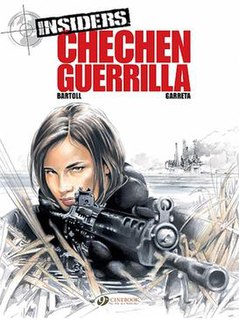 W
WInsiders is a Franco-Belgian comics series written by Jean-Claude Bartoll, illustrated by Renaud Garreta and published by Dargaud in French and Cinebook in English.
 W
WIR$ is a Franco-Belgian comics series written by Stephen Desberg, illustrated by Bernard Vrancken and published by Le Lombard in French and Cinebook in English.
 W
WLady S is a Franco-Belgian comics series written by Jean Van Hamme, illustrated by Philippe Aymond and published by Dupuis in French and Cinebook in English.
 W
WLargo Winch is a Belgian comic book series by Philippe Francq and Jean Van Hamme, published by Dupuis. It started as a series of novels by Van Hamme in the late 1970s, but stopped due to a lack of success and the huge amount of work Van Hamme had in the meantime with his comic books. When artist Philippe Francq wanted to start a series with Van Hamme, he revived his old hero, and reworked the novels into the first albums of the comic book series. Later, more stories followed.
 W
WThe Legendaries is a comic book series created in 2004 by Patrick Sobral and published by Delcourt. It is set in a world called Alysia. The Legendaries are five heroes who, in an attempt to stop an evil sorcerer named Darkhell from using the Stone of Jovénia,one of six magical stones used to create the world of Alysia, were unable to keep it from shattering, causing everyone, themselves included, to revert to childhood. Blamed by the people of Alysia for the "Jovénia Incident", the Legendaries split up, only to be reunited by their erstwhile leader Danael in an attempt to undo the spell and restore their adulthood. Sales for the comic books began in October 2012. The comic books sold over 2 million copies.
 W
WLigne claire is a style of drawing created and pioneered by Hergé, the Belgian creator of The Adventures of Tintin. It uses clear strong lines all of the same width and no hatching, while contrast is downplayed as well. Cast shadows are often illuminated, and the style often features strong colours and a combination of cartoonish characters against a realistic background. All these elements together can result in giving comics drawn this way a flat aspect. The name was coined by Joost Swarte in 1977.
 W
WThe term "Marcinelle school" or "Charleroi school" refers to a group of Belgian cartoonists formed by Joseph Gillain following World War II. Marcinelle school cartoonists were all associated with the weekly magazine, Spirou, whose offices in the 1940s were located in the town of Marcinelle, near Charleroi in Belgium.
 W
WMélusine is a Belgian comic strip created by artist Clarke and writer Gilson that features short, humorous stories that centre on the life of a young witch who lives as an au pair in a castle and studies at a witches’ school. The strip first appeared in Spirou magazine in 1992. Since 1995, her adventures have been published in book form by Dupuis—the 27th album came out in 2019. Five albums have been published in English by Cinebook.
 W
WOrbital is a Franco-Belgian science fiction comics series written by Sylvain Runberg, illustrated by Serge Pellé and published by Dupuis in French and Cinebook in English.
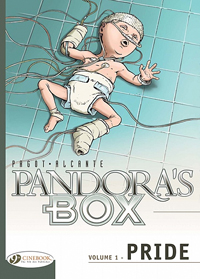 W
WPandora's Box is a Franco-Belgian comics series written by Alcante, illustrated by several artists and published by Dupuis in French and Cinebook in English.
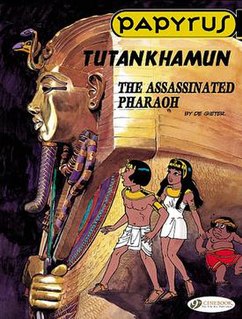 W
WPapyrus is a Belgian comic book series, written and illustrated by Lucien de Gieter. The story takes place in Ancient Egypt. It was first published in 1974 in Spirou magazine in the form of episodes.
 W
WLe Petit Vingtième was the weekly youth supplement to the Belgian newspaper Le Vingtième Siècle from 1928 to 1940. The comics series The Adventures of Tintin first appeared in its pages.
 W
WPierre Tombal is a Belgian gag comic strip, drawn by Marc Hardy and written by Raoul Cauvin, about a gravedigger and the dead people at his cemetery. The series has been in syndication since 1983 and is published in the Belgian magazine Spirou by Dupuis.
 W
WQueen Margot is a Franco-Belgian graphic novel series written by Olivier Cadic and François Gheysens, illustrated by Juliette Derenne and published by Chapeau Bas in French and Cinebook in English. Queen Margot is about the life of Margaret of Valois, who was Queen of France from 1589 to 1599.
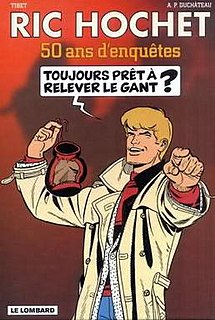 W
WRic Hochet is a Franco-Belgian comics series created by Tibet (drawings) and André-Paul Duchâteau (scripts). It first appeared on March 30, 1955 in the Franco-Belgian comics magazine Tintin.
 W
WLe Scorpion is a Franco-Belgian comics series written by Stephen Desberg, illustrated by Enrico Marini and published by Dargaud in French and Cinebook in English.
 W
WSpirou is a weekly Franco-Belgian comics magazine published by the Dupuis company. First published 21 April 1938, it was an eight-page weekly comics magazine composed of a mixture of short stories and gags, serial comics, and a handful of American comics, of which the most popular series would be collected as albums by Dupuis afterwards.
 W
WSpirou & Fantasio is one of the most popular classic Franco-Belgian comics. The series, which has been running since 1938, shares many characteristics with other European humorous adventure comics like The Adventures of Tintin and Asterix. It has been written and drawn by a succession of artists.
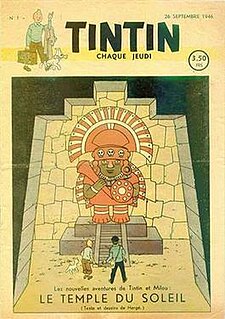 W
WTintin was a weekly Franco-Belgian comics magazine of the second half of the 20th century. Subtitled "The Magazine for the Youth from 7 to 77", it was one of the major publications of the Franco-Belgian comics scene and published such notable series as Blake and Mortimer, Alix, and the principal title The Adventures of Tintin. Originally published by Le Lombard, the first issue was released in 1946, and it ceased publication in 1993.
 W
WLes Tuniques Bleues is a Belgian series of bandes dessinées, first published in Spirou magazine and later collected in albums by Dupuis. Created by artist Louis Salverius and writer Raoul Cauvin, the series was taken up by artist Willy Lambillotte after Salverius' death. It follows two United States cavalrymen through a series of battles and adventures. The first album of the series was published in 1970. The series' name, Les Tuniques Bleues, literally "the bluecoats", refers to the Northern (union) army during the American Civil War. Cinebook has started to print the comics in English as "The Bluecoats" releasing Robertsonville Prison in 2008. It is one of the best-selling series in French-language comics.
 W
WValérian and Laureline, also known as Valérian: Spatio-Temporal Agent or just Valérian, is a French science fiction comics series, created by writer Pierre Christin and artist Jean-Claude Mézières. First published in Pilote magazine in 1967, the final installment was published in 2010. All of the Valérian stories have been collected in comic album format, comprising some twenty-one volumes plus a short story collection and an encyclopaedia.
 W
WWestern is a Franco-Belgian one shot comic written by Jean Van Hamme, illustrated by Grzegorz Rosinski and published by Le Lombard in French and Cinebook in English.
 W
WYoko Tsuno is a comics album series created by the Belgian writer Roger Leloup published by Dupuis in Spirou magazine since its debut in 1970. Through twenty-nine volumes, the series tell the adventures of Yoko Tsuno, a female electrical engineer of Japanese origin surrounded by her close friends, Vic Video and Pol Pitron. Their adventures bring them to, among other places, Belgium (Bruges), Germany, Scotland, Japan, Hong Kong, Indonesia and also into outer space. The stories are heavily technology driven, with concepts like robot dragons, suspended animation, time travel, and even an alien species called the Vineans. Despite the often exotic settings and science-fiction plot lines, the stories generally remain realistic on the personal level between the characters and friendship, love and spirituality are some of the key themes of the series. The art is drawn in Ligne claire style, although having originally started out in the Marcinelle style. When depicting real-world settings, Leloup aspires to be as true to reality as possible, with places like Burg Katz or Rothenburg ob der Tauber depicted with almost photographic skill.